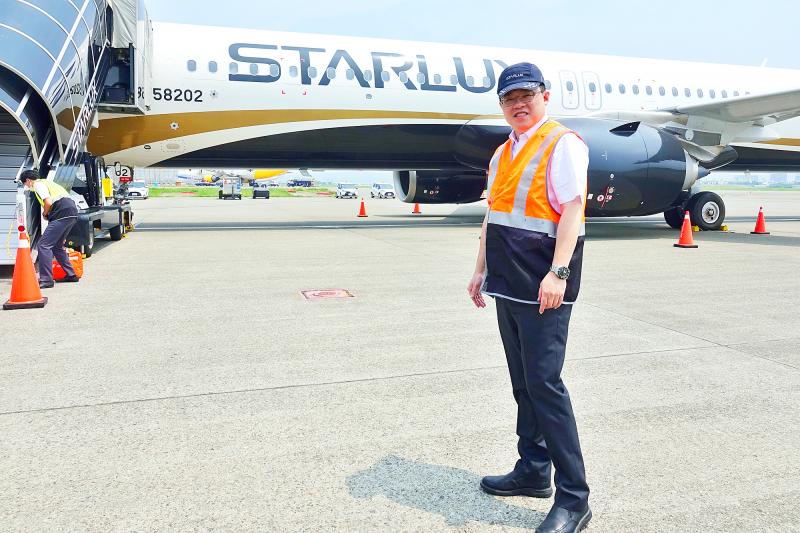Starlux Airlines Co (星宇航空) yesterday announced that it is to begin operating flights from Taiwan to the first-tier cities of Bangkok, Osaka and Tokyo from December in a bid to boost air cargo revenue.
The carrier is to provide two flights from Taiwan Taoyuan International Airport to Suvarnabhumi Airport in Bangkok each week from Dec. 1, two weekly flights to Kansai International Airport from Dec. 15 and two weekly flights to Narita International Airport from Dec. 16, it said.
Starlux would maintain one daily flight from Taiwan to Macau and two weekly flights to Penang, Malaysia, it said.

Photo: CNA
The airline’s announcement caught many off guard at a time when carriers have reduced their flights due to the COVID-19 pandemic.
StarLux had said that it wanted to focus on second-tier cities in Asia to avoid head-to-head competition.
Starlux chairman Chang Kuo-wei (張國煒) last year said that the carrier would not fly to first-tier cities in Asia until receiving five A350-900 wide-body jets late next year.
He said that flying with narrow-body aircraft, the carrier would be less competitive than those that operate wide-body jets to big cities.
“It is necessary to change our business strategy amid the pandemic,” Starlux general manager Glenn Chai (翟健華) said in a statement yesterday.
Starlux had focused on second-tier cities with strong tourism industries — Macau; Penang, Malaysia; and Da Nang, Vietnam — as its first three destinations.
The carrier must adapt to the pandemic, which has frozen international travel, Starlux spokesman Nieh Kuo-wei (聶國維) said by telephone.
“We do not think regular tourists would feel very interested due to the ongoing border controls, but on the other hand, as air cargo demand for the three new cities is strong, we could gain fresh air cargo revenue, which should be able to help us break even,” Nieh said.
Starlux plans to begin selling tickets for its new flights early next month, while it would adjust its schedule on a rolling basis, he said.
Last week, the carrier received its fourth narrow-body Airbus A321neo jet and plans to take delivery of the fifth by the end of this year, Nieh said.
It plans to take delivery of another eight A321neo airplanes next year, which means that the airline would announce new destinations at that time, he said.

Taiwanese suppliers to Taiwan Semiconductor Manufacturing Co. (TSMC, 台積電) are expected to follow the contract chipmaker’s step to invest in the US, but their relocation may be seven to eight years away, Minister of Economic Affairs J.W. Kuo (郭智輝) said yesterday. When asked by opposition Chinese Nationalist Party (KMT) Legislator Niu Hsu-ting (牛煦庭) in the legislature about growing concerns that TSMC’s huge investments in the US will prompt its suppliers to follow suit, Kuo said based on the chipmaker’s current limited production volume, it is unlikely to lead its supply chain to go there for now. “Unless TSMC completes its planned six

Intel Corp has named Tasha Chuang (莊蓓瑜) to lead Intel Taiwan in a bid to reinforce relations between the company and its Taiwanese partners. The appointment of Chuang as general manager for Intel Taiwan takes effect on Thursday, the firm said in a statement yesterday. Chuang is to lead her team in Taiwan to pursue product development and sales growth in an effort to reinforce the company’s ties with its partners and clients, Intel said. Chuang was previously in charge of managing Intel’s ties with leading Taiwanese PC brand Asustek Computer Inc (華碩), which included helping Asustek strengthen its global businesses, the company

Power supply and electronic components maker Delta Electronics Inc (台達電) yesterday said second-quarter revenue is expected to surpass the first quarter, which rose 30 percent year-on-year to NT$118.92 billion (US$3.71 billion). Revenue this quarter is likely to grow, as US clients have front-loaded orders ahead of US President Donald Trump’s planned tariffs on Taiwanese goods, Delta chairman Ping Cheng (鄭平) said at an earnings conference in Taipei, referring to the 90-day pause in tariff implementation Trump announced on April 9. While situations in the third and fourth quarters remain unclear, “We will not halt our long-term deployments and do not plan to

The New Taiwan dollar and Taiwanese stocks surged on signs that trade tensions between the world’s top two economies might start easing and as US tech earnings boosted the outlook of the nation’s semiconductor exports. The NT dollar strengthened as much as 3.8 percent versus the US dollar to 30.815, the biggest intraday gain since January 2011, closing at NT$31.064. The benchmark TAIEX jumped 2.73 percent to outperform the region’s equity gauges. Outlook for global trade improved after China said it is assessing possible trade talks with the US, providing a boost for the nation’s currency and shares. As the NT dollar